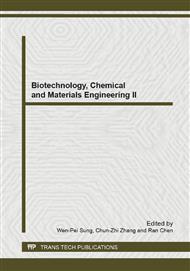p.824
p.828
p.834
p.838
p.841
p.845
p.850
p.854
p.858
Nafion/Quercetin/Graphene Composite-Modified Glassy Electrode for Selective and Sensitive Detection of Dopamine
Abstract:
Glassy carbon electrode (GCE) was modified using graphene (G), quercetin (Qu) and Nafion in this sequence to fabricate Nafion-Qu-G composite-modified GCE (Nafion/Qu/G/GCE). The as-prepared modified electrode combining the advantages of Nafion, Qu and G was employed for the selective and sensitive detection of dopamine (DA) in the presence of ascorbic acid (AA) and uric acid (UA). Compared with GCE, Qu/GCE, G/GCE and Qu/G/GCE, the Nafion/Qu/G/GCE was more electroactive and selective for DA. Differential pulse voltammetry (DPV) was used for electrochemical detection, the separations of the oxidation peak potentials for AA-DA and DA-UA were about 304 mV and 136 mV, which allowed selectively determining DA. In phosphate buffer solution (PBS) of pH 6.8, the Nafion/Qu/G/GCE provided a detection limit of 2.31×10-8 mol/L (S/N=3) for DA. Linearity (R=0.9963) of the peak currents against the concentration of DA was found over the range of 1.0×10-7 to 1.0×10-3 mol/L. Furthermore, the modified electrode exhibited good reproducibility and stability.
Info:
Periodical:
Pages:
841-844
Citation:
Online since:
January 2013
Authors:
Keywords:
Price:
Сopyright:
© 2013 Trans Tech Publications Ltd. All Rights Reserved
Share:
Citation:



